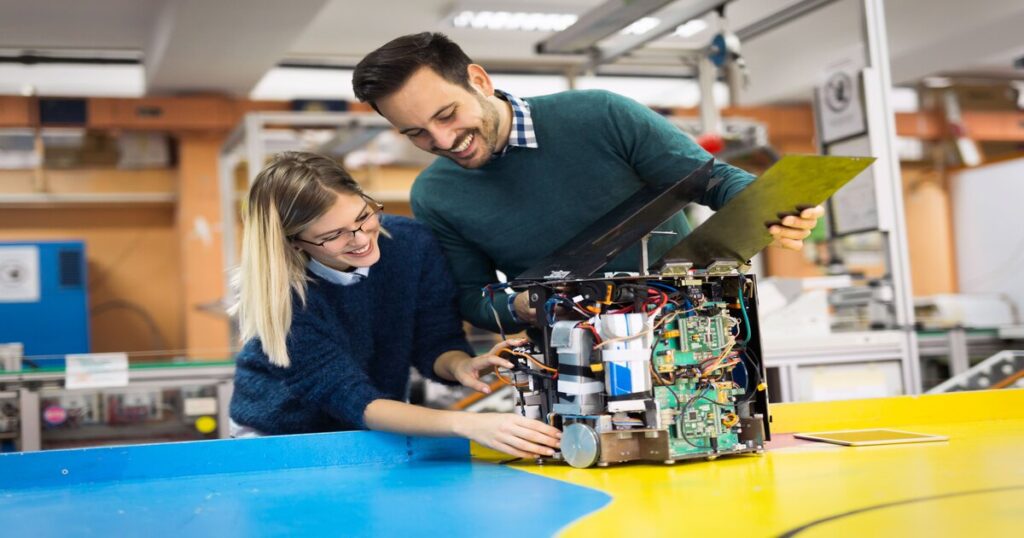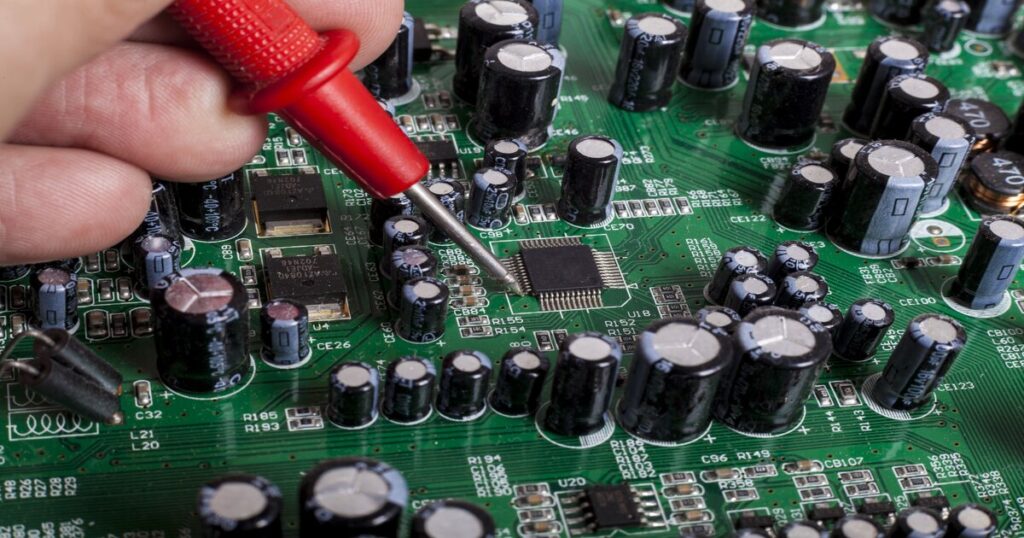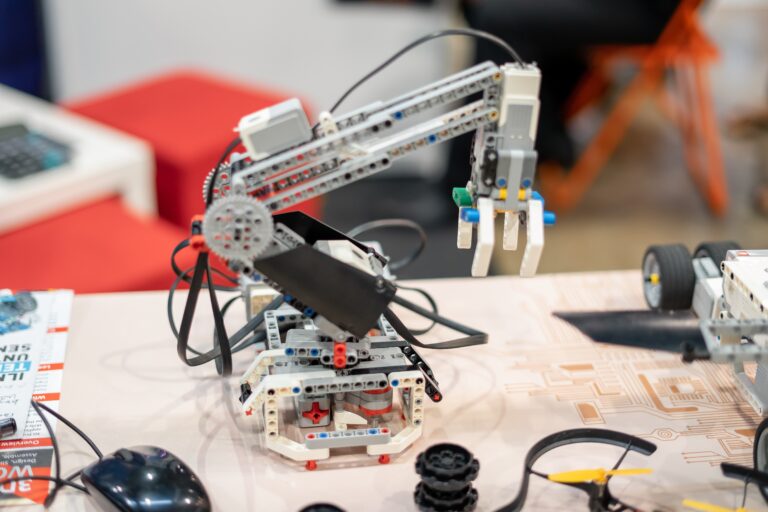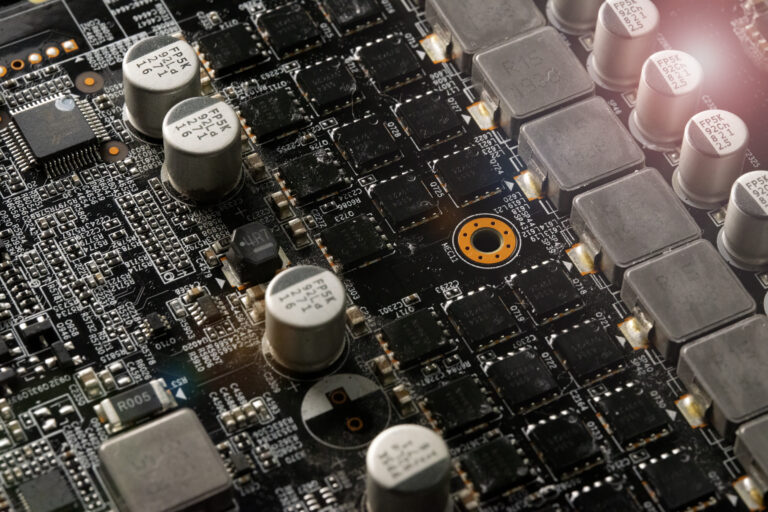Building the Autonomous World of Tomorrow with Mechatronics!
Mechatronics is the driving force behind today’s revolutionary breakthroughs, from elegant robotics to precision-driven automobile systems. In this article, we welcome you to embark on an exciting journey into the world of mechatronics, where creativity knows no bounds and possibilities are limitless.
Enter a world where mechanics and electronics coexist, and machines come to life with intelligence and automation. Welcome to the fascinating world of mechatronics, a science that combines the finest of several fields to create breathtaking technical wonders. Mechatronics is the driving force behind today’s revolutionary breakthroughs, from elegant robotics to precision-driven automobile systems. In this article, we welcome you to embark on an exciting journey into the world of mechatronics, where creativity knows no bounds and possibilities are limitless. Prepare to witness the confluence of mechanical talent, electronic wizardry, and computational brilliance as we unravel the mysteries of this enthralling area. Are you ready to be captivated? Begin your voyage into the enchanted world of mechatronics!
This article will cover the mechatronics industry and how it has transformed a variety of sectors, including manufacturing and healthcare. We will explore the underlying ideas that underpin this interdisciplinary area, look at how it is applied in real-world situations, and talk about the amazing developments it has resulted in. Join us on this thrilling adventure into the world of mechatronics, where innovation and technology combine to form the future, by fastening your seatbelt!
What is Mechatronics?
Mechatronics is a multidisciplinary area that designs and develops intelligent and automated systems by combining mechanics, electronics, informatics, automation, and robotics. It entails combining mechanical, electronic, and software components to produce advanced machines and gadgets capable of performing difficult tasks.
“Mechatronics” is a combination of the words “mechanics” and “electronics.” Tetsuro Mori, an engineer, first used the phrase to express the interdependence of mechanical machinery and electrical control systems in 1969.
Engineers that specialize in mechatronics use their understanding of electronics, computer programming, and mechanical principles to create original solutions. They participate in all stages of product creation, from conception and design to production and upkeep. They want to build systems and machines that are more intelligent, dependable, and efficient.
The incorporation of sensors and actuators into mechanical systems is a crucial component of mechatronics. Feedback on the system’s performance and surroundings is provided by sensors including cameras, temperature sensors, and accelerometers. The system’s ability to move mechanically and be controlled is made possible by actuators such as motors, solenoids, and hydraulic systems. Mechatronic systems can adapt to changing situations and make judgments in real time by fusing sensors, actuators, and clever control algorithms.
Mechatronic systems that are algorithmically controlled have an architectural system;
Hierarchy: Objects, names, and values are arranged in hierarchies according to their practical or aesthetic superiority.
Polyarchy: The division of responsibilities among many systems for various functions.
Heterarchy: A working system with mixed functions.
Hybrid: A hybrid is a product or functional system that results from the combination of two distinct functional entities.
Software is essential in mechatronics for directing and coordinating the various system parts. To make the mechanical and electronic components communicate, programming languages and algorithms must be created. Software programming enables engineers to create sophisticated control schemes, run system simulations, and examine sensor data.
Numerous technological advances can be attributed to the discipline of mechatronics. For instance, industrial automation systems have transformed the way that manufacturing processes are done by increasing productivity, accuracy, and safety. In fields including automotive assembly, logistics, and healthcare, robotic systems—a shining example of mechatronics—have become indispensable.
Applications of Mechatronics
Numerous different areas and industries use mechatronics. In addition to manufacturing, automotive, aerospace, robotics, healthcare, and consumer electronics, it is essential in many other fields as well. Mechatronics is used in manufacturing to create robotic systems and automated assembly lines that increase productivity.
Role of Mechatronics in the Manufacturing Sector
Mechatronics has been used in a wide number of sectors and businesses. It plays a key role in several areas, including manufacturing, automotive, aerospace, robotics, healthcare, and consumer electronics. Mechatronics is used in advanced driver-assistance systems (ADAS), electric power steering, and intelligent braking systems in the automotive industry. Mechatronics is used in aerospace to build and manage aircraft systems including fly-by-wire controls and navigation systems.
The incorporation of Mechatronics is responsible for the production process’s high degree of automation. Industrial robots deliver consistently fast performance, allowing businesses to meet demand while spending less money. Manufacturing has embraced “smart” technology to guarantee maximum efficiency, just like many other industries.
Mechatronics plays a key role in the design and control of CNC machines, which are widely used in manufacturing. Precision machining of components is made possible by mechatronic systems, which provide exact and repeatable movements of cutting tools.
Automation of quality control and inspection systems is made possible by mechatronics. To identify flaws, these systems employ a variety of sensors and imaging techniques, guaranteeing that only goods that adhere to rigid quality requirements are shipped to customers.
Designing and implementing cutting-edge control systems for manufacturing machinery is a part of mechatronics. These systems make sure that everything runs precisely and consistently, maximizing efficiency and preserving product quality all the way through manufacturing.
Sensors are used by mechatronic systems to collect information on different process variables and product traits. Actuators respond to sensor inputs and modify process parameters in real-time to maintain quality and efficiency. Actuators are controlled by microcontrollers or PLCs (Programmable Logic Controllers).
The development and incorporation of robots and automated systems into manufacturing processes are made possible by mechatronics. Robotic arms and automated assembly lines improve processes, boost effectiveness, and cut down on errors, boosting output and bringing down costs.
The goal of mechatronics is to create human-machine interfaces that are simple and easy to use. These interfaces make it possible for technicians and operators to efficiently connect with intricate industrial systems, monitoring and regulating procedures in real-time.
The Role of Mechatronics in the Medical Sector
Mechatronics, which combines mechanical engineering, electronics, control systems, and computer science, is now becoming crucial in the field of medicine because it develops revolutionary technologies.
Automated medication delivery systems, such as programmable infusion pumps and implantable drug delivery devices, are being developed with the help of mechatronics. These systems include exact control mechanisms, sensors, and feedback loops to guarantee controlled and correct medicine administration to patients.
Devices used for physical therapy, mobility assistance, and help for people with disabilities are designed and developed with a significant contribution from mechatronics. In order to help patients regain and enhance their motor skills, technologies like robotic exoskeletons, assistive walking aids, and neurorehabilitation tools include sensors, actuators, and control systems.
Another application of mechatronics in the field of medicine is medical imaging systems. Mechatronics is widely employed in the construction of sophisticated medical imaging systems like X-ray machines, computed tomography (CT) scanners, magnetic resonance imaging (MRI) machines, and ultrasound devices. Complex mechanical movements, accurate placement, and integration with electronic sensors and control systems are all part of these systems.
By creating surgical robots, mechatronics has revolutionized minimally invasive surgery. These machines help surgeons carry out delicate and exact treatments while increasing precision and minimizing invasiveness. Robotic arms can replicate human movements thanks to mechatronic technologies, which improve their flexibility and accuracy.
Vital sign monitors, wearable sensors, and implanted medical devices are just a few examples of patient monitoring technologies that are being developed using mechatronic systems. These devices make use of sensors to gather physiological data, process it using electronic circuits, and then deliver timely feedback to medical practitioners for precise patient diagnosis.
The creation of sophisticated prosthetic limbs and exoskeletons has been considerably aided by mechatronics. Mechatronic prostheses can perform more effectively by incorporating sensors, actuators, and control systems, giving users better control and a more realistic experience. Exoskeletons, on the other hand, help people with mobility problems by boosting their strength and allowing them to move around or carry out physical daily tasks.
Role of Mechatronics in Education
By expanding learning opportunities, offering practical training, and preparing students for professions in a variety of technological sectors, mechatronics plays a key role in education.
By bridging the disciplines of mechanical engineering, electronics, and computer science, mechatronics offers students an interdisciplinary learning environment. It promotes a comprehensive grasp of complex systems and problem-solving abilities, both of which are essential in today’s technologically advanced society.
Practical applications and hands-on learning are highlighted in mechatronics. Mechatronics labs can be built in educational institutions so that students can work with real robotic systems, automation tools, sensors, and actuators. Their knowledge of theoretical topics is improved by this actual exposure, and they feel more comfortable using cutting-edge technologies.
Collaborations with businesses that employ cutting-edge technology are frequent in the education of mechatronics. These collaborations can provide doors for internships and job placements while giving students insightful information about the practical use of mechatronics.
In instructional robotics courses where students construct and program robots, mechatronics is frequently used. These pursuits nurture a love of technology at a young age by developing teamwork, problem-solving, and programming skills.
The promotion of STEM (Science, Technology, Engineering, and Mathematics) education can be greatly aided by mechatronics. By illustrating how these topics are used in real-world situations and making learning engaging, it piques students’ interest in these disciplines.
Technology breakthroughs drive a steady evolution in the field of mechatronics. Institutions foster a culture of lifelong learning in students by incorporating mechatronics into the curriculum. This encourages students to stay current on technological advancements and to be adaptive in their employment.
Students that study mechatronics are prepared for a wide range of job paths, such as robotics engineering, automation and control systems, industrial maintenance, and manufacturing. Educational institutions can better match their programs to the needs of the labor market and make sure that graduates are prepared for cutting-edge technical employment by incorporating mechatronics into their courses.
Projects in mechatronics give students the chance to work on actual problems, fostering innovation and creativity. Project-based learning develops teamwork, critical thinking, and problem-solving skills, whether students are developing an automated system or creating a basic robotic arm.
PCBWay
Known for its expertise in delivering printed circuit board (PCB) manufacture and assembly services, PCBWay is a renowned and well-established business. One of the top companies for PCB fabrication and assembly in the market is PCBWay, which has its headquarters in China.
PCBWay provides quick and effective PCB fabrication services. They have the capacity to manufacture a wide variety of PCB types, including single-sided, double-sided, and multilayer boards with different materials and surface treatments. PCBWay offers services for PCB assembly in addition to PCB creation. Offering comprehensive solutions for diverse projects, they are capable of handling both through-hole component assembly and surface-mount technology (SMT).
Both productions runs and prototypes are catered to by PCBWay. Smaller production runs for established enterprises, as well as projects for makers, startups, and hobbyists, can be handled by them with ease. Additionally, they give customers the option to upload their PCB designs and specifications, enabling them to obtain specially built PCBs that meet the demands of their particular projects.
The procedure is streamlined and effective because of its user-friendly web platform, which enables clients to simply place and track their orders. PCBWay provides PCB design services in addition to PCB manufacturing and assembly, guaranteeing that clients will receive complete assistance throughout the course of their project.
Customers can get technical support from PCBWay, which helps them with any problems or inquiries they could have when ordering PCBs. Solder paste stencils, which are essential for precise and effective solder paste application during PCB assembly, are available from PCBWay.
Mechatronics Projects with PCBWay
If you need to fabricate and assemble PCBs for a variety of applications, including mechatronics, electronics, industrial, and consumer goods, PCBWay is a dependable and trustworthy partner. Worldwide, engineers, amateurs, and corporations favor them because of their dedication to quality, quick turnaround times, and superior customer service. For those who are interested in electronics, their community platform will be a terrific resource. PCBWay may be a helpful partner when it comes to developing and manufacturing custom PCBs for mechatronics projects to fit diverse requirements. The services of PCBWay can be used to complete the project ideas listed below in the mechatronics field.
Quadcopter Drone
Build a quadcopter drone with the help of specially made PCBs for the flight controller, motor drivers, and communication modules. The drone’s electronic components are effectively incorporated into the airframe thanks to PCBWay’s fabrication capability.
Smart Watch
With the help of PCBWay’s bespoke PCB fabrication services, develop a wearable gadget like a smartwatch or fitness tracker. To match the form factor of the wearable and house sensors and microcontrollers, they can manufacture small, flexible PCBs.
Home Automation System
Create a home automation system that enables remote management of lighting, fans, and other equipment. The fabrication of PCBs by PCBWay guarantees dependable connection and easy integration for the central control unit and numerous sensor modules.
CNC Machine Controller
Custom PCBs from PCBWay can be used to create a CNC machine controller. The exact control of the movements of the CNC machine is made possible by this controller’s ability to communicate with stepper motors and sensors.
Automated Pet Feeder
Construct an automatic pet feeder that releases food at predetermined intervals. The project is made more dependable and user-friendly by the usage of bespoke PCBs from PCBWay for the control system, motor drivers, and user interface. The PCB fabrication and assembly services provided by PCBWay can be used to complete a variety of mechatronics applications. Mechatronics projects can benefit from PCBWay‘s expertise in PCB fabrication by receiving dependable and high-quality custom PCBs, regardless of the size of the project or the complexity of the commercial application.
Conclusion
As a cutting-edge interdisciplinary field that combines mechanical, electrical, and computer science principles, mechatronics is at the vanguard of contemporary engineering. It has a wide range of uses, from robotics and automation to medicine and consumer electronics. Industry revolutions have been sparked by mechatronics, which promotes innovation, increases productivity, and improves the quality of life for everyone. Mechatronics continues to influence how we engage with technology by turning ideas into practical solutions through its capacity to design intelligent, interconnected systems. Mechatronics will undoubtedly play an increasingly important role in determining how our world develops as we move farther into the future, advancing technology and improving the comfort, convenience, and sustainability of our lives.









